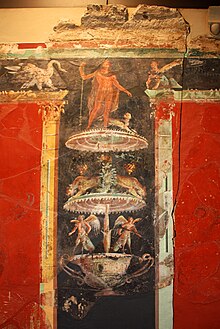Wall painting from Insula H / 1, room 1434
The wall painting from Insula H / 1, room 1434 is one of the best preserved Roman wall paintings in Germany . The Roman building was in Cologne, immediately south of today's cathedral, in front of the Blau-Gold-Haus . The excavations took place in 1969/70 when an underground car park was built in this area.
Most of the painting fragments were found in a layer of clay under a floor, other parts were still stuck to the wall. They decorated a room that was once 7.8 meters long and about 4 meters wide. Above all, the paintings on the two longitudinal walls could largely be reconstructed and are now exhibited in the Roman-Germanic Museum . The house to which the paintings belonged has only been partially excavated, so a complete plan cannot be reconstructed. In addition, the building has been rebuilt and expanded several times, which makes the reconstruction of a plan even more difficult.
The west wall of room 1434 is best preserved. Above a plinth zone that is 20 cm high and which, with colorful speckles, probably imitates marble on a pink background, is followed by another 40 cm high plinth zone in which narrow red and wide black fields alternate. These once contained figurative scenes, of which only one example is better preserved. Above the base zone there is a 14 cm wide strip over which the main decoration is painted. Here narrow black fields (above the red fields of the base zone) alternate with large red panneaux (above the black fields of the base zone). There are figural decorations in the black, narrow fields. A black stripe over the red panneaux is also decorated with figurative representations. The large red panneaux are bordered by painted pilasters with Corinthian capitals . They are alternating green and yellow and carry an egg truss .
The wall shows four panneaux with five narrow bounding fields. The three middle black fields each have a painted, shielded candelabra . The middle field is the widest, the two left and right of it a bit narrower, the two outer ones are the narrowest and show only a blade of grass. The individual candelabra shades are decorated with figures. In the middle field there is a representation of Dionysus at the grape harvest as the upper end of the candelabra. In the left field there is the image of Pomona and in the right field again Dionysus. Here he is shown with a panther . Swans, sphinxes and griffins are shown in the stripe above the red fields .
The other long wall is not so well preserved. However, the general structure of the decoration is identical. Here, too, there was a vintage scene in the middle, black field. The figure on one of the side candelabra is no longer preserved, the other shows a seated Dionysus. It is uncertain whether this was painted to the right or left of the midfield. In the red field under the middle black field you can see an erot as a Bellerophon and a chimaira . A chariot race and a picture of a partridge in other fields of the base zone were poorly preserved.
The two short walls are even worse preserved, but here a red field seems to have occupied the center of the wall. Here, too, you can find candelabra in the adjacent black fields.
The paintings are among the highest quality from Roman Germania. They probably date to the second half of the first century AD.
literature
- Andreas Linfert : Roman wall painting of the north-western provinces , Cologne 1975
- Renate Thomas : Roman wall painting in Cologne , von Zabern, Mainz 1993 (Kölner Forschungen, Vol. 6) ISBN 3-8053-1351-9 , pp. 177-198

